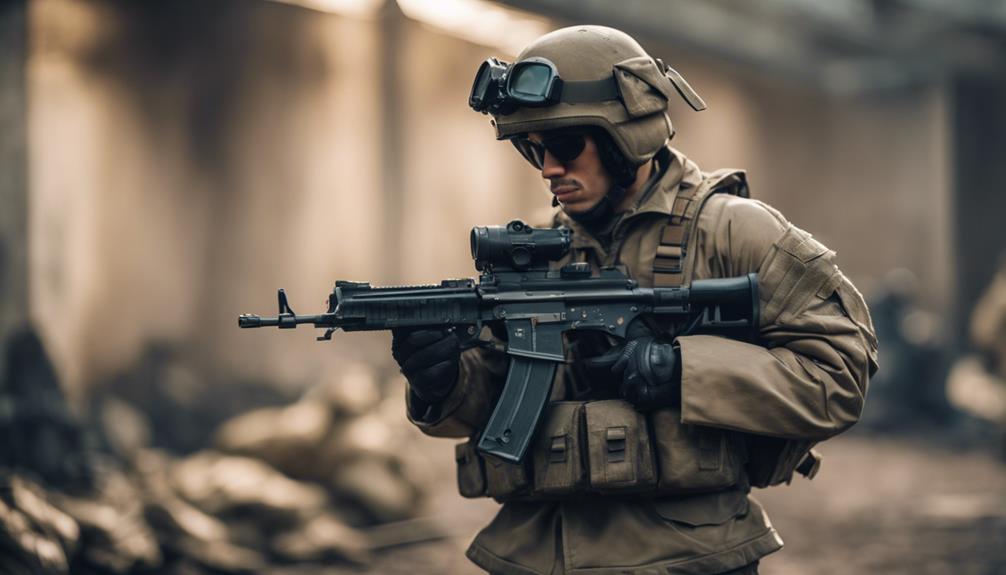For the ultimate defense, a flak jacket is your go-to protective gear, shielding you from bullets and shell fragments in combat situations. Originally used during WWII for bomber crews, it has evolved from steel to advanced materials like Kevlar, ensuring your safety. Aligning with armor development standards, modern flak jackets offer unmatched protection. Their impact in reducing casualties makes them indispensable. If you want to discover more about the history, materials, and innovation behind this pivotal gear, keep exploring the evolution of flak jackets and how they shape the future of protective wear.
Key Takeaways
- Flak jackets are protective gear originally developed for aircrew during World War II.
- They shield against debris, shell fragments, and bullets, evolving from steel plates to Kevlar fabric.
- Flak jackets adhere to ballistic protection standards for reliable defense in combat scenarios.
- Continuous material innovation ensures they offer necessary protection levels against various ammunitions.
- Collaboration with museums and historical armor designs has influenced the evolution of modern protective gear.
History of Flak Jackets
Flak jackets first emerged during World War II to shield aircrew from debris and shell fragments. The first flak jackets were designed to provide protection, particularly to aircrew in the Eighth Air Force facing the dangers of anti-aircraft fire. While these early flak jackets weren't bulletproof, they played a pivotal role in safeguarding individuals against high explosive weaponry, minimizing the impact of shrapnel and debris during combat missions.
The historical significance of flak jackets is deeply intertwined with the experiences of bomber crews and gunners in World War II. As the term 'flak jacket' originates from the German word 'Fliegerabwehrkanone,' meaning 'anti-aircraft gun,' it highlights the primary purpose of these protective garments – defense against anti-aircraft fire.
The evolution of flak jackets over time has seen them become lighter and more effective against specific threats, solidifying their place as essential gear for individuals facing combat scenarios.
Evolution of Materials
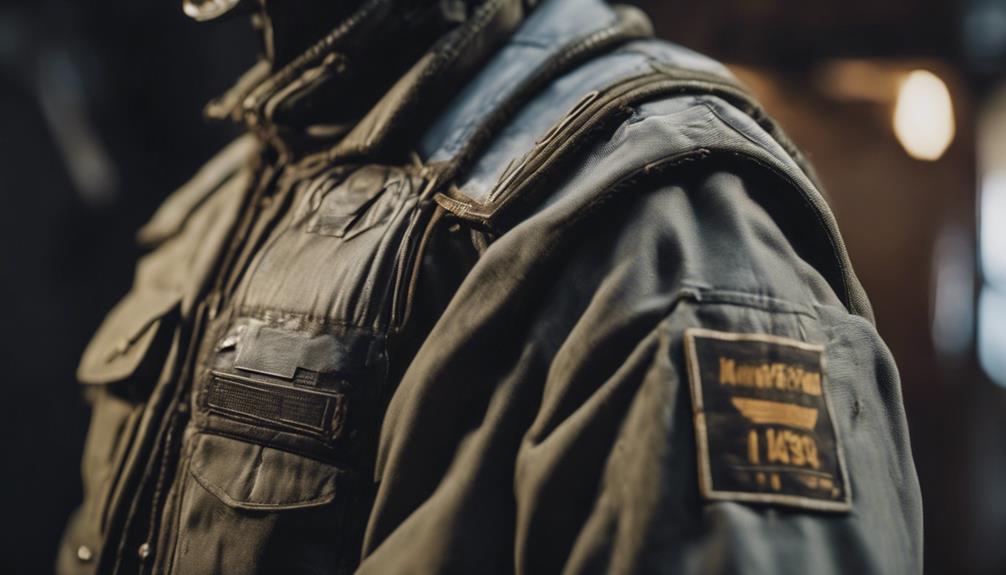
You'll explore the timeline of material advancements that transformed flak jackets from steel plates to ballistic nylon and polyethylene stiffeners, revolutionizing their protective capabilities.
The innovation in U.S. Army vests with ballistic nylon and polyethylene stiffeners, alongside U.S. Marine flak vests incorporating Doron plates, marked significant milestones in enhancing soldier safety.
Discover how the introduction of soft armor layers like DuPont's Kevlar fabric in the 1970s reshaped the landscape of flak jacket effectiveness.
Material Advancements Timeline
Throughout history, advancements in materials have played a pivotal role in the evolution of protective gear like flak jackets. Flak jackets have seen a significant evolution in materials over time, shifting from rigid steel plates to more flexible options like ballistic nylon during the Korean and Vietnam wars.
The U.S. Army vests, for instance, integrated ballistic nylon and polyethylene stiffeners to enhance protection, while U.S. Marine flak vests utilized Doron plates as part of their defensive gear. However, the game-changer came in the 1970s with the introduction of soft armor layers such as DuPont's Kevlar fabric. This innovation revolutionized body armor, offering improved flexibility and protection.
These advancements marked a significant leap forward in the protective capabilities of flak jackets, although they still provided limited defense against bullets and shell fragments compared to modern ballistic vests. The evolution of materials continues to drive the enhancement of protective gear, ensuring the safety of military personnel in challenging environments.
Flak Jacket Innovation
Amid ongoing progress in materials, the development of flak jackets has been characterized by a shift from rigid steel plates to more flexible and innovative options.
Historical flak jackets, created in the 1860s, primarily aimed to shield against debris and shell fragments rather than bullets. As conflicts progressed, materials like ballistic nylon, Doron plates, and polyethylene stiffeners were integrated during the Korean and Vietnam wars to enhance ballistic protection. These improvements aligned with the National Institute of Justice's standards for armor development, guiding the shift towards more effective designs.
While flak jackets weren't intended to provide full-fledged bulletproof capabilities, their evolution paralleled that of modern ballistic vests. Today's flak jackets have become lighter and more efficient in safeguarding against specific threats, emphasizing agility and comfort without compromising protection.
Although they aren't designed to withstand direct gunfire like modern ballistic vests, the continuous innovation in materials ensures that flak jackets remain an essential component of personal protective equipment for individuals facing ballistic hazards.
Ballistic Protection Standards
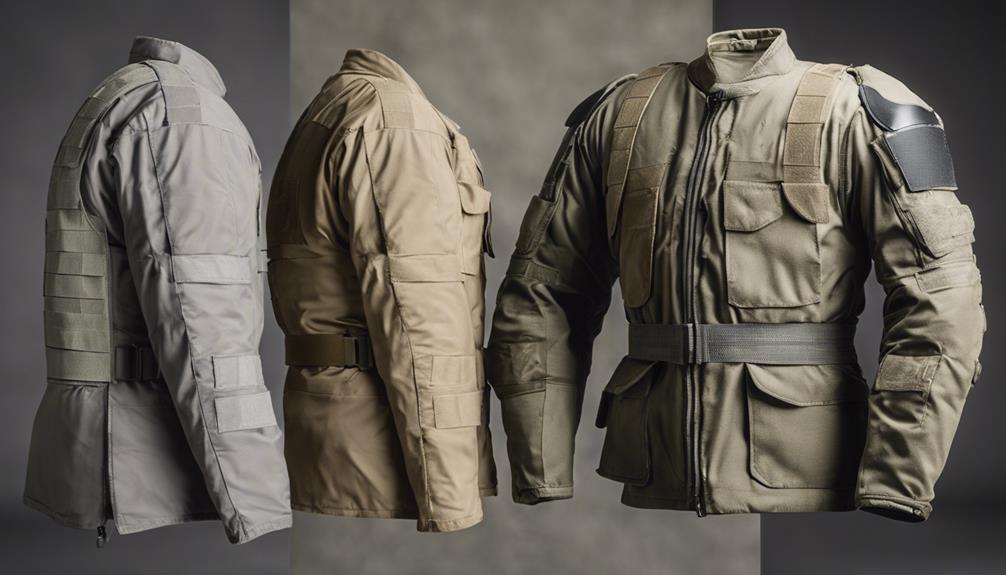
You need to understand the standards for ballistic protection when it comes to flak jackets. Ensuring compliance with these guidelines is vital for the effectiveness of the gear.
Standards for Protection
Body armor manufacturers must adhere to ballistic protection standards established by organizations like the National Institute of Justice to guarantee the effectiveness and reliability of their products. These criteria ensure that body armor vests provide the necessary level of protection against different types of ballistic threats, including handguns, rifles, and armor-piercing rounds.
Compliance with NIJ standards is crucial as it determines the armor's capability to withstand the impact of various ammunitions. Manufacturers perform thorough testing, such as shooting samples with standardized ammunition, to evaluate if the body armor meets the required protection levels.
Following these standards is vital for law enforcement, military personnel, and civilians who rely on body armor for their safety and security. By following these guidelines, manufacturers can offer users the confidence that the body armor they're wearing has been tested and validated to provide the specified level of protection.
Compliance With Guidelines
To guarantee the effectiveness and reliability of protective gear like flak jackets, compliance with established ballistic protection standards, such as those set by the National Institute of Justice (NIJ), is vital. Flak jackets are specifically designed to protect against explosive threats and shell fragments rather than gunfire, making adherence to NIJ standards essential for securing their intended level of protection.
These standards are continuously updated to reflect advancements in materials and technology, ensuring that flak jackets evolve to meet the changing demands of modern combat environments. Military personnel facing explosive threats rely on flak jackets as a critical component of their protective gear, highlighting the importance of compliance with NIJ standards to maximize their safety and survivability in dangerous situations.
Helmet Models in History

Throughout history, various helmet models have been utilized, including the M59/85, Hełm wz. 50, Hełm wz. 63, Hełm wz. 67, and Hełm wz. 93. These helmets played a pivotal role in protecting the head during combat and other dangerous situations. Below is a comparison table highlighting some key features of these historical helmet models:
| Helmet Model | Origin | Material |
|---|---|---|
| M59/85 | Yugoslavia | Steel |
| Hełm wz. 50 | Poland | Steel |
| Hełm wz. 63 | Poland | Steel |
| Hełm wz. 67 | Poland | Steel |
| Hełm wz. 93 | Poland | Composite |
These helmets, despite variations in design and materials, all served the common purpose of safeguarding soldiers in the line of duty. The evolution of helmet technology has come a long way, paving the path for the advanced and modern helmet models we see today.
Modern Helmet Models

In the field of protective headgear advancements, modern helmet models stand as cutting-edge innovations in safeguarding military personnel. These helmets offer a range of features aimed at enhancing ballistic protection and ensuring the safety and comfort of soldiers in combat situations.
The A2 Helmet is one such model that provides enhanced ballistic protection, shielding against various threats faced on the battlefield. Its design incorporates advanced materials and technologies to offer reliable defense for the wearer.
On the other hand, the FAST helmet is renowned for its lightweight construction and compatibility with accessories, allowing for customization based on mission requirements.
Moreover, the IHPS helmet prioritizes improved comfort alongside enhanced protection, catering to the needs of soldiers during extended periods of wear.
The ECH (US) helmet meets stringent military standards for ballistic resistance, ensuring reliability in high-risk scenarios.
Lastly, the BK-3 helmet is specifically designed to offer best head protection for tactical operations, further underscoring the importance of modern helmet models in the field of military gear.
Impact of Flak Jackets

During World War II, the impact of flak jackets on military personnel's safety and survival can't be understated. These bulletproof vests revolutionized protection against flak injuries, greatly enhancing the chances of survival in combat situations.
Here are some key points highlighting the impact of flak jackets:
- Flak caused 70% of wounds in the Eighth Air Force during WW2, emphasizing the urgent need for improved armor to protect against these dangers.
- Surgeon Malcolm Grow's advocacy for light armor for gunner protection was instrumental in pushing for the development of the flak jacket, showcasing the importance of medical input in armor design.
- Collaboration between the Air Force and armor specialists led to the creation of the Armor Vest M6, a standardized flak jacket based on the 1400s brigandine design, demonstrating the evolution of armor technology to meet modern warfare challenges.
Collaboration With Museums
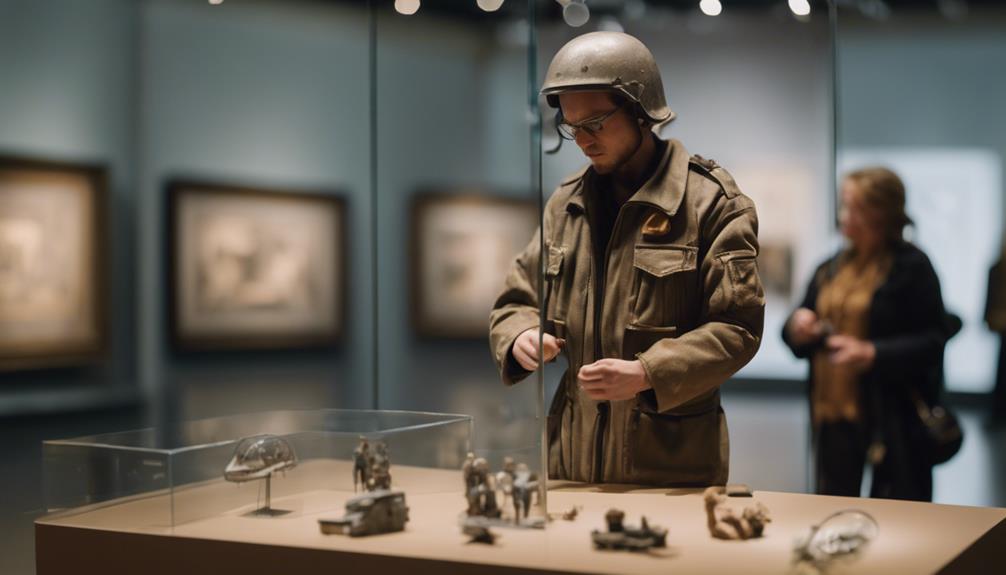
You'll find that the collaboration with museums brought a unique blend of historical design inspiration to modern body armor. Insights drawn from studying various armor types in museums like the Metropolitan Museum of Art played a vital role in shaping the evolution of protective gear.
The incorporation of elements from historical armors like jousting armor and scale armor showcases the significant impact of museum collaborations on the development of protective gear.
Museum Armor Influence
The collaboration with museums greatly impacted the evolution of modern body armor design, drawing inspiration from historical armor pieces. This partnership with the Metropolitan Museum of Art's armor workshop led to significant advancements in protective gear, shaping the development of innovative flak jackets and body armor.
Insights gained from studying various historical armor types like jousting armor and scale armor influenced the adaptation of designs for contemporary protective wear. The Armor Vest M6, inspired by a 1400s brigandine from the museum's collection, became a standardized piece of protective gear known for its effectiveness.
Historical armor pieces like jousting armor and scale armor provided design inspiration.
The Armor Vest M6, based on a 1400s brigandine, became a widely adopted protective gear.
Insights from studying different eras of armor at the museum influenced the development of modern body armor by the Air Force.
Historical Design Inspiration
Drawing inspiration from historical armor pieces, the collaboration with museums greatly influenced the design of modern body armor, particularly the development of the Armor Vest M6. Armor specialists, in partnership with institutions like the Metropolitan Museum of Art, explored the intricacies of historical armor such as jousting armor and scale armor to derive insights for creating effective protective gear.
By studying various types of armor in museum collections, designers were able to adapt centuries-old techniques into cutting-edge protective equipment.
The Air Force, in collaboration with armor specialists, carefully examined historical armor pieces to draw inspiration for the design of flak jackets. The Armor Vest M6, modeled after a 1400s brigandine, emerged as a standardized flak jacket due to the fusion of historical design elements with modern technology.
This innovative approach highlights the importance of historical design inspiration in shaping the evolution of protective gear, ensuring both functionality and historical relevance are seamlessly integrated.
Significance of Body Armor Evolution

As body armor has evolved, its significance in enhancing soldier protection has become increasingly apparent. The advancements in armor made today offer superior protection against modern ballistic threats and armor-piercing rounds. The development of body armor has focused on improving the strength-to-weight ratio, ensuring that soldiers are adequately protected without being weighed down by heavy gear.
Additionally, the integration of soft bulletproof materials has revolutionized the comfort and flexibility of body armor, making it easier for soldiers to maneuver in various combat scenarios.
The collaboration with armor specialists and the incorporation of historical insights have played an essential role in shaping the evolution of body armor. By drawing inspiration from historical armor designs and leveraging cutting-edge technology, modern body armor continues to push the boundaries of soldier protection.
These advancements not only enhance the safety of soldiers on the battlefield but also reflect the ongoing commitment to improving defense mechanisms for military personnel.
Kevlar in Body Armor
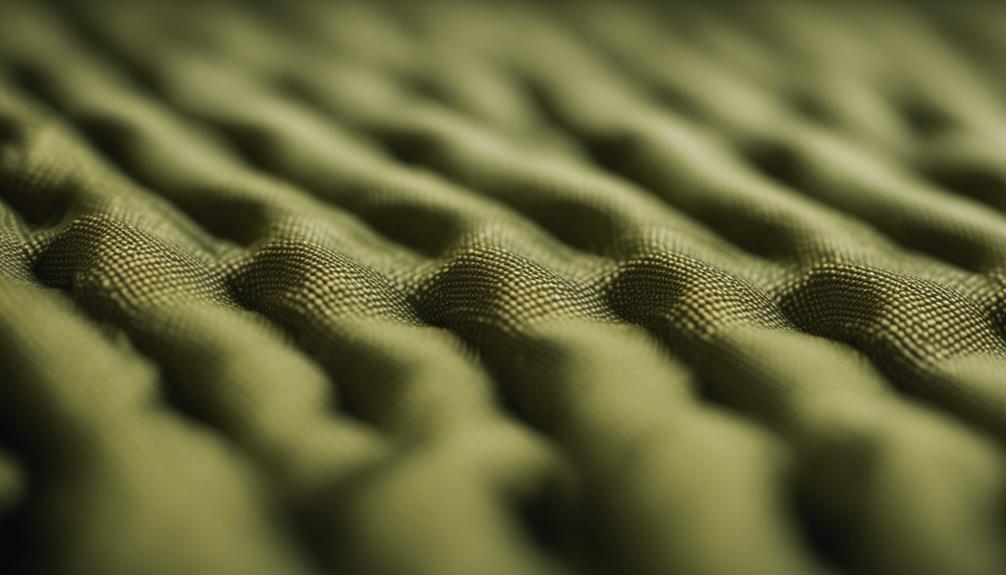
With its exceptional strength and lightweight properties, Kevlar stands as an essential element in modern body armor design. Developed by DuPont in 1965, Kevlar is a para-aramid synthetic fiber known for its remarkable strength-to-weight ratio, surpassing that of steel by five times.
This unique characteristic makes Kevlar fabric a popular choice in body armor, especially in soft armor applications where flexibility and comfort are vital.
Body armor incorporating DuPont's Kevlar is widely recognized for its bullet and stab-resistant capabilities, offering wearers a higher level of protection. Kevlar's versatility extends beyond standalone use; it's often integrated into composite materials to enhance ballistic protection, meeting various NIJ levels for body armor standards.
Originally utilized in car racing tires, Kevlar made a pivotal shift to body armor in the 1970s, revolutionizing the protective gear industry with its unparalleled strength and durability.
Development of Ballistic Protection Materials
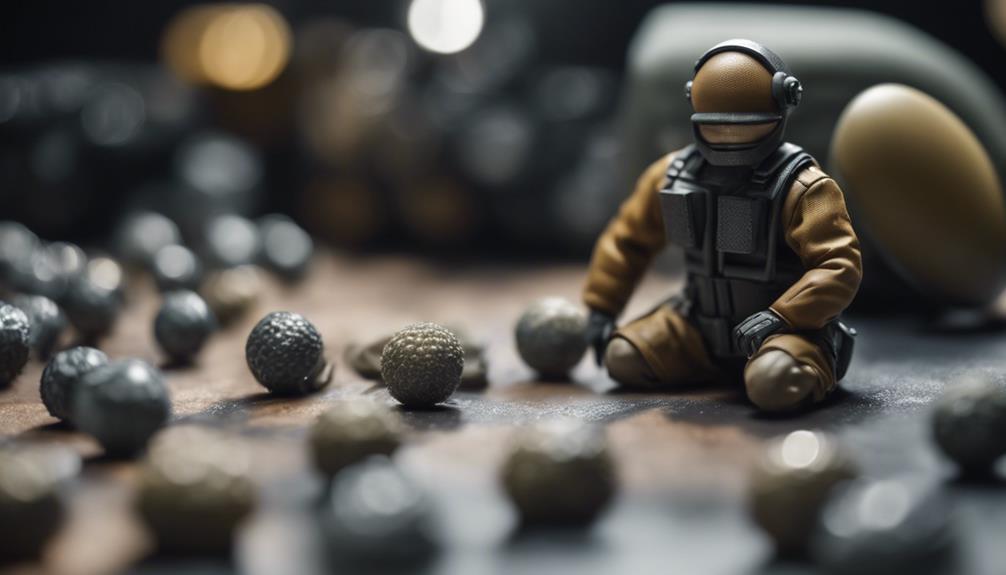
The evolution of ballistic protection materials has been driven by advancements in technology and the need for enhanced safety in various fields. Over the years, the development of materials used in creating protective gear has played a pivotal role in improving the effectiveness of bullet-proof vests. Some key points to keep in mind in this evolution include:
- Liquid Crystalline Fibers: Introduction of high-performance fibers like Kevlar marked a notable advancement in ballistic protection.
- Para-Aramid and Ultra-High Molecular Weight Polyethylene Fibers: Modern bullet-proof vests are constructed using commercially used polymer fibers like para-aramid and ultra-high molecular weight polyethylene fibers.
- T65-2 Vests: The T65-2 vests, introduced in 1967, were a breakthrough as they were capable of stopping rifle rounds, showcasing a remarkable leap in ballistic protection technology.
These advancements have greatly enhanced the safety and protection offered by ballistic gear, making them more efficient in safeguarding individuals from ballistic threats.
Frequently Asked Questions
What Does a Flak Jacket Protect Against?
Flak jackets primarily protect against high explosive weaponry and shell fragments, offering limited defense from gunfire. While not bulletproof, they can provide some protection against certain bullets. Originating in World War II, flak jackets have evolved to become lighter and more effective.
What Is the Difference Between a Flak Jacket and a Bulletproof Vest?
A flak jacket differs from a bulletproof vest as it shields against high explosive weaponry and shell fragments, not bullets. It's essential for military personnel facing explosive threats in combat zones, absorbing impacts to safeguard lives.
How Effective Is a Flak Jacket?
Flak jackets offer protection against high explosive weaponry and shell fragments, not gunfire. They evolved from heavy steel plates to lighter materials like ballistic nylon, providing limited defense against bullets but focusing on shrapnel and debris.
Can Civilians Buy Flak Jackets?
Yes, civilians can buy flak jackets. Regulations vary, so it's essential to research before purchasing. While not all civilian versions offer military-grade protection, modern advancements have made them more accessible, but understand their limitations.
Conclusion
So, there you have it – the fascinating evolution of the flak jacket! From humble beginnings to high-tech materials, these protective gears have come a long way.
Next time you see one, remember the incredible history and advancements that have made them so effective.
Stay safe and stylish with your flak jacket, and keep on enjoying the ultimate protection it provides!

